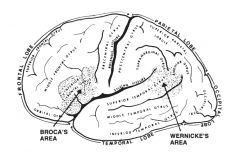![]()
![]()
![]()
Use LEFT and RIGHT arrow keys to navigate between flashcards;
Use UP and DOWN arrow keys to flip the card;
H to show hint;
A reads text to speech;
48 Cards in this Set
- Front
- Back
|
semantics
|
main area of linguistics concerned with meaning
|
|
|
lexical semantics
|
meanings of individual words
|
|
|
linguistic meaning
|
semantic meaning (definition)
|
|
|
speaker meaning
|
intended meaning of the speaker
|
|
|
idiom
|
phrases that can convey non-literal meaning
|
|
|
semantic relations b/w words
|
hyponymy, synonymy, antonymy, ambiguity
|
|
|
hyponymy
|
meaning of a word includes or entails that of another word
|
|
|
antonym
|
words that share one aspect of meaning but are opposite in terms of each other
|
|
|
synonymy
|
words/ expressions that mean the same thing
|
|
|
ambiguity
|
words with multiple semantic interpretations
|
|
|
semantic interpretation depends not just on the meaning of lexical items, but also on...
|
...how lexical items are combined; semantic interpretation is partially determined by the syntax
|
|
|
advantages of writing systems
|
- store for knowledge greater than individual memory
- lasts beyond the individual - retains consistency |
|
|
precursors to writing systems
|
- Diepkloof eggshells
- Blombos caves - Petroglyphs - Counting tokens |
|
|
cuneiform
|
earliest known writing system; sumerian ideagrams
|
|
|
pictographic script
|
picture/ symbol represents whole word/ concept
|
|
|
syllabic script
|
symbol represents possible syllable
|
|
|
morphemic script
|
symbol represents a morpheme
|
|
|
phonemic scripts
|
symbol/ symbols represent individual phoneme
|
|
|
rebus principle
|
refers to the practice of using existing symbols, such as pictograms, purely for their sound regardless of their meaning, to represent new words
|
|
|
emoticons
|
strings of text characters that, when viewed sideways, form a face and convey a particular emotion
|
|
|
2 sister species of humans
|
Homo denisova, Neanderthal
|
|
|
2 cousin species of humans
|
Homo erectus, Homo floriziesus
|
|
|
LCA
|
Homo hidobrigensus
|
|
|
2 key genes related to language and the brain
|
FOXP2, Sargap2C
|
|
|
language "evolution"
|
animal language --> PROTOLANGUAGE --> human language
|
|
|
physical reasons humans developed language
|
bigger brain, larynx, genes
|
|
|
language processing occurs in...
|

|
|
|
Broca's area
|
front part of the brain's left hemisphere
|
|
|
Wernicke's area
|
area of left hemisphere in temporal lobe
|
|
|
Broca's aphasia
|
loss of ability to express oneself
|
|
|
Wernicke's aphasia
|
loss of ability to understand what is being said or read
|
|
|
linguistic competence
|
the knowledge of a language represented by the mental grammar that accounts for the speakers' linguistic ability and creativity (unconscious knowledge)
|
|
|
linguistic performance
|
the use of linguistic competence in the production and comprehension of langauge
|
|
|
prescriptivism
|
the idea that there is one standard or correct way to speak a language
|
|
|
proto-Indo-European
|
languages including Latin, Sanskrit, Greek, German, and English are thought to derive from this one common language spoken around 6000-8000 years ago
|
|
|
English belongs to the __________ language family
|
Germanic
|
|
|
languages that had an influence (especially in providing loan words) in English
|
French, Latin, German
|
|
|
regional dialect
|
regional or geographic difference in the use of language
|
|
|
social dialect
|
socio-economic/ class differences in the use of language
|
|
|
dialect
|
variation in the use of langauge by speakers of the same native language
|
|
|
The Nostratic Hypothesis
|
the idea that some of the world's major language families may derive from a common root language spoken during the last ice age
|
|
|
Black Sea Deluge Theory
|
may explain the initial migration of the Proto-Indoeuropeans across Europe and Asia 6500 years ago
|
|
|
parameters and the lexicon are responsible for...
|
...the variation we see in human langauge
|
|
|
characteristics of human language that make it unique
|
- contain nounie and verbie constituents
- contain bound and free morphemes - no such thing as a primitive language |
|
|
morpho-syntactic features of language provide the structure that allows us to link...
|
...sound and meaning
|
|
|
poverty of the stimulus argument shows...
|
- human language is an infinite system
- infinite systems are unlearnable - human syntactic abilities are innate |
|
|
word
|
collection of phonetic-phonological features, morpho-syntactic features, and semantic features
|
|
|
explanatory adequacy
|
linguistic theory must provide explanation for observational data, native-speaker judgements/ intuitions, and language acquisition
|

